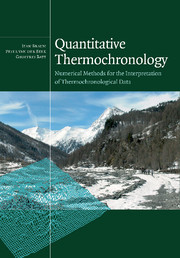Description
Quantitative Thermochronology
Numerical Methods for the Interpretation of Thermochronological Data
Authors: Braun Jean, Beek Peter van der, Batt Geoffrey
This 2006 book presents numerical modeling techniques and case studies to explore geochronological isotopic age data.
Language: English
Subject for Quantitative Thermochronology:
Approximative price 58.78 €
In Print (Delivery period: 14 days).
Add to cart
Quantitative Thermochronology : Numerical Methods for the Interpretation of Thermochronological Data
Publication date: 09-2012
272 p. · 17x24.4 cm · Paperback
Publication date: 09-2012
272 p. · 17x24.4 cm · Paperback
Approximative price 112.82 €
Subject to availability at the publisher.
Add to cart
Quantitative thermochronology: numerical methods for the interpretation of thermochronological data
Publication date: 05-2006
272 p. · 17x24.4 cm · Hardback
Publication date: 05-2006
272 p. · 17x24.4 cm · Hardback
Description
/li>Contents
/li>
Thermochronology, the study of the thermal history of rocks, enables us to quantify the nature and timing of tectonic processes. First published in 2006, Quantitative Thermochronology is a robust review of isotopic ages, and presents a range of numerical modeling techniques to allow the physical implications of isotopic age data to be explored. The authors provide analytical, semi-analytical and numerical solutions to the heat transfer equation in a range of tectonic settings and under varying boundary conditions. They then illustrate their modeling approach built around a large number of case studies. The benefits of different thermochronological techniques are also described. Computer programs on an accompanying website at www.cambridge.org/9781107407152 are introduced through the text and provide a means of solving the heat transport equation in the deforming Earth to predict the ages of rocks and compare them directly to geological and geochronological data. Several short tutorials, with hints and solutions, are also included.
1. Introduction; 2. Basics of thermochronology; 3. Thermochronological systems; 4. General heat transport equation; 5. Thermal effect of exhumation; 6. Steady-state two-dimensional heat transport; 7. General transient solution; 8. Inverse methods; 9. Detrital thermochronology; 10. Lateral advection of material; 11. Lithopheric flexure; 12. The evolution of passive margin escarpments; 13. Thermochronology in active tectonic settings; Appendices; References; Index.
© 2024 LAVOISIER S.A.S.
These books may interest you

Geochronology and Thermochronology 101.39 €

Geochronology and Thermochronology 157.49 €


